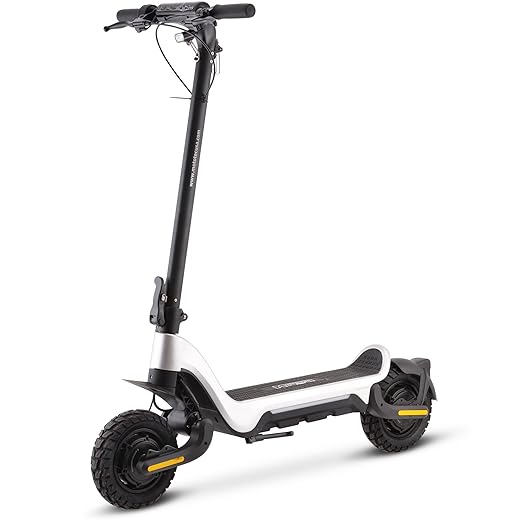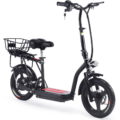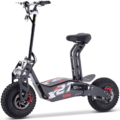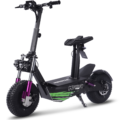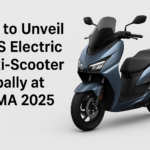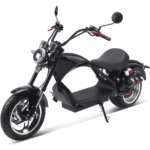- Home
- Scooters
- Electric Scooters
- MotoTec Fury
MotoTec Fury


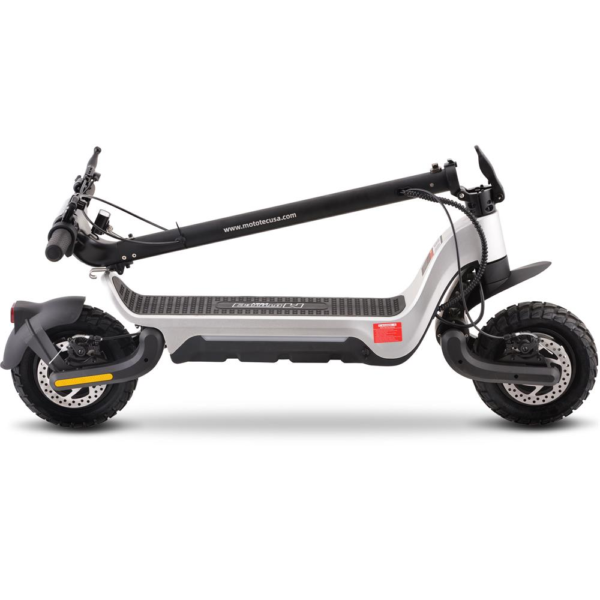
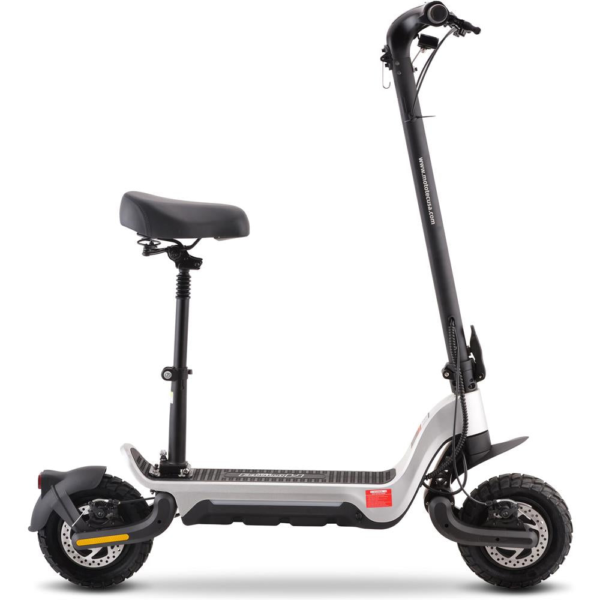
- Battery Range: 15–30 miles (24–48 km)
- Top Speed: 31 mph (50 km/h)
- Motor Power: 1000 W
- Weight Capacity: 265 lb (120.2 kg)
- Charging Time: ~4–6 h
- Scooter Weight: 62.0 lb (28.1 kg)
PROS
- 31 mph top speed
- 48 V 18 Ah (864 Wh) lithium pack
- Front & rear suspension
- Front & rear disc brakes
- IPX4 splash resistance
- LCD meter with speed/distance
CONS
- Heavy to carry (62 lb)
- No companion app
- Regenerative braking not listed
- Range varies widely with mode/weight
Key Takeaways
- The MotoTec Fury is a dual-motor scooter designed for city and light trail use, featuring a removable seat and sturdy suspension.
- It delivers strong torque with dual brushless hub motors and a robust 48V battery, providing a range of 15–30 miles.
- The scooter includes a lightweight aluminum frame, front and rear suspension, and mechanical disc brakes for a smooth ride.
- With a top speed of 31 mph and sit-or-stand versatility, it’s suitable for various riding conditions, especially in urban areas.
- The MotoTec Fury requires regular maintenance and offers easy storage with its folding design, making it convenient for daily use.
Table of contents
- What Is the MotoTec Fury?
- How the MotoTec Fury Works
- Key Specifications
- Design & Build Quality
- Performance Fundamentals
- Battery, Range & Efficiency
- Ride Quality & Comfort
- Braking & Safety Features
- Portability & Daily Usability
- Maintenance & Care
- Weather & Seasonal Considerations
- MotoTec Fury vs Alternatives
- Who the MotoTec Fury Is (and Isn’t) For
- FAQs
- Glossary
- Design & Setup Tips (Quick Start)
- Ownership Notes
- Final Thoughts
The MotoTec Fury is a dual-motor, sit-or-stand scooter made for city streets and light trails. It hits hard off the line, rolls smooth at cruise, and stays easy to care for at home. So it fits riders who want strong torque, a removable seat, and real suspension without fuss.
If you want a simpler city ride from the same brand, the MotoTec Metro is a mellow pick, and our MotoTec Metro review walks through how it feels in daily use.
What Is the MotoTec Fury?
The MotoTec Fury runs a 48-volt system with two brushless hub motors. It includes front and rear suspension, a thumb throttle, an LCD for speed and trip data, and cable disc brakes at both wheels. You get a folding frame for storage. And you can bolt on the seat in minutes, then pull it off just as fast.
This setup targets real use. You might commute across town, handle errands, then hit a park path. So the Fury blends speed, range, and sturdy parts that handle bumps without odd quirks.
How the MotoTec Fury Works
Electric scooters keep a simple layout, and this one sticks to it.
Motors and controller. Two brushless hubs sit inside the wheels. The controller links your thumb input to both motors with a smooth power ramp. So torque builds cleanly, and you can choose one-motor or two-motor drive based on the route.
Battery. A 48 V, 18 Ah lithium pack stores about 864 Wh. That’s enough for daily trips without a bulky deck. It sits inside the deck for protection and a low center of gravity. So the scooter stays settled at speed.
Throttle and display. A thumb lever feeds power. The LCD shows speed and distance, and it’s readable in daylight. Small inputs make small changes. So slow zones and tight spaces feel calm.
Brakes. Two mechanical discs handle the stops. Bite starts early, then firms up as you pull. The rotors are visible, so you can spot pad wear at a glance.
Lights. A front LED headlight throws a short, wide beam. The rear light brightens on brake. So drivers and riders behind you catch the signal fast.
In short, the system is easy to read, easy to wrench on, and easy to ride at a steady pace.
Key Specifications
These are the official specifications, shown in both units for quick scanning. So you can compare across similar models without guessing.
General
| Item | Spec |
|---|---|
| Model | MotoTec Fury |
| Recommended age | 13+ years |
| Max rider weight | 265 lb (120 kg) |
| IP rating | IPX4 (splash-resistant) |
| Display | LCD speedometer/odometer |
| Seat | Removable |
Performance & Power
| Item | Spec |
|---|---|
| Motors | Dual brushless hub motors |
| System voltage | 48 V |
| Rated output | 1000 W (combined) |
| Top speed | Up to 31 mph (50 km/h) |
| Speed modes | 2 selectable |
| Drive modes | 1- or 2-motor operation |
Battery, Charging & Electrical
| Item | Spec |
|---|---|
| Battery | 48 V 18 Ah lithium (≈ 864 Wh) |
| Range per charge | 15–30 mi (24–48 km) |
| Charge time | 4–6 hours |
| Headlight | LED |
| Rear brake light | Yes |
Build & Dimensions
| Item | Spec |
|---|---|
| Frame | Aluminum alloy |
| Tires | 255×80, 10-inch pneumatic |
| Suspension | Front and rear |
| Brakes | Front & rear disc |
| Size (L×W×H) | 48 × 21 × 49 in (122 × 53 × 125 cm) |
| Folded (L×W×H) | 48 × 21 × 22 in (122 × 53 × 56 cm) |
| Weight | 62 lb (28.1 kg) |
Safety & Control
| Item | Spec |
|---|---|
| Throttle | Thumb |
| Lighting | Headlight + rear brake light |
| Reflectors | Not specified |
| Electronic brake/regen | Not listed |
Features & Extras
| Item | Spec |
|---|---|
| Folding | Yes |
| Seat post | Included, removable |
| Display functions | Speed, distance |
| Cruise Control | Not listed |
Warranty & Compliance
| Item | Spec |
|---|---|
| Warranty | 30-day parts replacement |
| Box size/weight | 49 × 9 × 24 in; 71 lb |
These specifications place the MotoTec Fury in the mid-power, full-suspension class with sit-or-stand flexibility. And they show a balance between punch, comfort, and simple upkeep.
Design & Build Quality
The frame uses aluminum alloy for strength without big weight. The deck is tall enough to house the 48 V pack and wiring. And it still leaves real foot space for a natural stance. The stem locks with a straightforward latch. Set it right once, and it stays tight. So torsional flex stays low at city speeds, and steering inputs feel precise.
The cockpit is clean and familiar. You get a thumb throttle, two cable brake levers, and an LCD that stays readable in sun. Cable routing runs along the stem and dips under the deck, so cleaning and checks go fast. Parts use common sizes. So swaps for grips, levers, and pads are easy.
Fit and finish meet the class. Edges line up, welds look tidy, and fasteners sit where you can reach them. The seat hardware clamps down without rattles when you set the post and collar well. So the scooter feels solid on patched asphalt and rough blocks.
Performance Fundamentals
Starts and sprints. With both motors live, the Fury jumps off the line. The 0–15 mph push feels lively, so short merges and quick passes stay simple. Then the pull flattens into a smooth climb toward the high 20s. The last few mph to 31 take more road, since wind drag ramps up fast.
Cruising stability. The 10-inch pneumatic tires track straight on mixed pavement. And the dual suspension takes the edge off sharp hits. So the bar stays calm at 15–25 mph on clean roads. At top speed on broken patches, a light shimmy can show up if your grip loosens. A steady stance and correct tire pressure keep it in check.
Hill behavior. On 7–10% grades, two-motor mode matters. The scooter holds a usable pace on short climbs and avoids bogging near the crest. One-motor mode still clears mild hills, yet it slows sooner. So pick two-motor for long grades, heavy loads, or frequent stops.
Battery, Range & Efficiency
The 48 V, 18 Ah pack holds about 864 Wh. That’s your energy budget for a ride. At an easy city pace near 15–20 mph on flat ground, plan for roughly 25–35 Wh per mile. So a full charge can cover about 15–30 miles. Cold weather, soft tires, steep hills, or headwinds will trim that number.
Charging from near empty takes around 4–6 hours with the stock charger. For long pack life, keep most day-to-day charges between 40% and 80% when you can. Then give it a 100% balance charge every few weeks to keep cell groups even. And let the pack cool to room temp before you plug in after a hard ride.
Temperature changes the feel. Lithium cells like mild conditions. So store the scooter inside and away from heat. In winter, range drops. Then you can slow a bit or plan shorter routes to land at a safe state of charge.
Ride Quality & Comfort
Tires and suspension set the tone. The Fury rolls on 10-inch pneumatic tires with a 255×80 profile. So you get real air volume and a round patch on the road. The dual shocks smooth pothole edges and small curbs taken at a crawl. Hands and feet stay fresh across long blocks.
The deck gives enough space for a shoulder-width stance. You can angle one foot and square the other for balance. Bar height fits average riders, and the seat adds comfort on longer runs. Then you can remove the seat for stand-up rides that need more body movement.
Vibration control is solid on mixed pavement. On gravel or broken concrete, the suspension still helps, yet tire pressure and speed matter more. So drop the pace, pick clean lines, and stay loose over rough sections.
Braking & Safety Features
Two mechanical discs slow the scooter with a firm, predictable feel. The levers give early bite and a steady ramp to full stop. So modulation stays consistent in dry and damp conditions. The Fury doesn’t list motor-based regen, so plan your speed and leave room for the mechanical system to work.
Lighting covers basic night needs. The LED headlight lights the near field. The rear light signals when you brake. For dark routes, add a reflective vest or a helmet light. Then check local rules on night riding before you make it a habit.
The scooter carries an IPX4 splash rating. So it tolerates light spray, not immersion or pressure washing. Heavy rain adds risk for electronics and traction. For safety and lifespan, keep wet rides brief and cautious.
Portability & Daily Usability
At 62 lb (28.1 kg), the Fury is fine for short lifts but not long stair hauls. The fold drops height to 22 in (56 cm), so it slides into a trunk or under a bench. Length stays 48 in when folded, which helps with along-the-wall storage. And the latch is direct: fold, seat the stem, then engage the catch until it clicks.
Carry the scooter by the stem near the clamp or by a deck cutout. For home or office floors, drop a small rubber mat under the wheels. Then loop a heavy U-lock through the frame and rear wheel when you park outside. A compact charger at your desk makes lunch top-ups painless on long days.
Maintenance & Care
Short, regular checks keep everything tight and safe. So build a simple routine and stick to it.
Before each ride
- Check tire pressure and look for cuts.
- Squeeze both brake levers and confirm a firm feel.
- Wiggle the stem at the clamp and confirm no play.
- Glance at axle nuts and rotor bolts.
Every two weeks
- Inspect brake pads and replace when the lining gets thin.
- Check spoke tension if your wheels use spokes, tightening evenly.
- Verify fasteners on the stem, fork crown, and deck hardware.
Monthly
- Clean and lube brake cables if the pull feels rough.
- Check folding latch alignment if the stem starts to creak.
- Charge to 100% once to balance cell groups.
Battery habits
Store the scooter in a cool, dry place. Keep it out of direct sun and away from heaters. For winter storage, park near half charge and top up monthly. So the pack stays healthy between rides.
Weather & Seasonal Considerations
Water and temperature change the ride. IPX4 covers splash, not storms. So avoid deep puddles, strong spray, and pressure washers. Wet roads cut grip, and stopping distances grow. Slow down early and brake in a straight line.
Cold eats into range. Plan shorter trips below freezing, and roll at a calmer pace. Heat matters too. On hot days, park in the shade and let the pack cool before charging. Then check tire pressure more often, since pressure rises with temperature.
MotoTec Fury vs Alternatives
Against light commuters. Versus 350–500 W commuters, the Fury launches harder, climbs better, and rides softer on rough blocks. Heavy riders get more headroom. Weight and size are the trade-offs.
Against mid-tier commuters. Versus single-motor 600–800 W models, the Fury brings two-motor traction and stronger starts. It weighs more and takes more room when folded, yet it feels calmer at speed.
Against big off-road models. Versus 1600–2000 W scooters, the Fury costs less and stays easier to carry. Those larger rigs win on raw speed, long grades, and big-hit suspension. So pick them if you live on steep hills or rough ground.
All told, the Fury sits in the middle lane. It pairs real punch with friendly manners and a workable fold.
Who the MotoTec Fury Is (and Isn’t) For
Great for
- Riders who want sit-or-stand flexibility.
- City trips of 5–12 mi (8–19 km) each way.
- Heavier riders who want strong starts and steady braking.
- Mixed-surface routes where suspension helps.
Not ideal for
- Daily stair carries over many flights.
- Long high-speed routes that need huge packs.
- Riders who plan to ride in heavy rain a lot.
If your routine matches the first list, the MotoTec Fury will feel like the right tool. And it will do the job day after day.
FAQs
How fast does it go, and how stable is it at speed?
It reaches up to 31 mph (50 km/h) on flat ground. And the chassis stays calm through the high 20s on clean pavement.
What range can I expect at a steady 20 mph on flat roads?
Plan for about 18–25 miles for an average-weight rider with correct tire pressure. Cold and hills will lower that figure.
Does the MotoTec Fury have cruise control?
Cruise control isn’t listed. So plan to hold the thumb lever on longer runs.
Can I ride it in the rain?
It carries an IPX4 splash rating. So light spray is fine, but heavy rain and deep puddles raise risk and can damage parts.
How long does a full charge take?
A full charge takes about 4–6 hours with the stock charger. Short top-ups during the day work well for back-to-back trips.
What tire pressure should I use?
Follow the sidewall range for your tires. Then check pressure weekly, since small tires lose air faster.
Where can I read a short MotoTec Fury overview?
This page is the MotoTec Fury overview in one place. It covers the core traits, the specifications, and the care tips you’ll use.
Glossary
Ah (amp-hours). A measure of how much charge a battery holds. Higher Ah means more stored charge.
Wh (watt-hours). Volts times amp-hours. It shows total energy in the pack.
Brushless hub motor. A motor built into the wheel that uses electronic switching. It runs quiet and needs little service.
Controller. The unit that manages power from the battery to the motors. It turns throttle input into torque.
Thumb throttle. A small lever near the grip that you press with your thumb to control speed.
Torque. The twisting force a motor makes. More torque means stronger starts and better hill pull.
Regen. Short for regenerative braking. It turns motion into charge when slowing. The Fury relies on discs and doesn’t list regen.
Stem flex. Side or fore-aft movement felt at the handlebar. Less flex gives more precise steering.
IP rating. A code that shows protection against dust and water. IPX4 means splash-resistant.
Disc brake. A rotor and caliper system that slows the wheel with pads. It gives strong, repeatable stops.
Speed mode. A setting that caps power and speed to match road or battery needs.
Pneumatic tire. An air-filled tire that cushions the ride and grips well.
Balance charge. A full charge that lets the battery system align cell groups.
Watt. A unit of power. Higher watts can mean stronger acceleration and a higher top speed.
Grade. The steepness of a hill, shown as a percent. A 10% grade rises 10 m for every 100 m forward.
Design & Setup Tips (Quick Start)
- Set bar angle so your wrists stay neutral at cruise speed.
- Align the front wheel, then tighten the stem clamp evenly.
- Test both brakes in a safe area before you ride in traffic.
- Start in the lower speed mode until you learn the feel.
- Keep a small pump and a multi-tool in your bag for quick fixes.
Ownership Notes
You’ll spend more time riding than wrenching. Pads wear slowly with clean rotors. Chains and belts aren’t part of this drive, so it stays quiet and clean. And most parts use standard sizes, so upgrades for grips, lights, or levers are simple.
Final Thoughts
The MotoTec Fury mixes dual-motor snap, full suspension, and sit-or-stand comfort in a package you can maintain at home. It’s not feather-light, and it’s not a long-range tourer. Even so, it nails daily trips, short hills, and mixed roads. If that sounds like your week, this scooter will serve you well.
Specifications
General
| Model The Model specifies the exact version or name of the scooter. It helps identify its unique design, features, and specifications within the manufacturer’s product line. Knowing the model makes it easier to compare options, find compatible accessories, or look up support information. | Fury |
| Brand The Brand identifies the manufacturer or company that designs and produces the scooter. A trusted brand is a sign of quality, reliability, and good customer support. Well-known brands often have higher standards for safety, performance, and after-sales service, giving you more confidence in your purchase. | MotoTec |
| Release Date The Release Date indicates when the scooter model was officially launched on the market. This helps you know how current the design, technology, and features are. A newer release date often means updated components, improved performance, and the latest safety or smart features. | 18 November 2025 |
| Recommended Age Recommended Age indicates the minimum age range that the scooter is designed for, based on safety, size, and ease of use. Following the recommended age helps ensure that riders can handle the scooter’s speed, weight, and controls comfortably and safely. Always check local laws and use protective gear, especially for younger riders. | 13+ |
Performance & Power
| Motor Power (Wattage) What it means: The motor power, measured in watts (W), shows how strong the scooter’s electric motor is. Why it matters: Higher wattage usually means better acceleration, more torque, and improved performance on hills or rough terrain. For example, a 250W motor is good for flat city roads and light riders, while a 500W or 1000W motor provides more power for faster speeds or climbing steep inclines. | 48 V 1000 W rear hub (brushless) |
| Top Speed The Top Speed indicates the maximum speed that the scooter can reach under optimal conditions. It’s usually measured on level ground with a fully charged battery and an average rider weight. A higher top speed allows you to travel longer distances faster, but always ensure you ride within legal speed limits and your personal comfort zone for safety. | 31 mph (50 km/h); 2 selectable speeds |
| Battery Capacity Battery Capacity refers to the total amount of energy the scooter’s battery can store, usually measured in ampere-hours (Ah) or watt-hours (Wh). A higher battery capacity means you can ride longer distances on a single charge, reducing the need for frequent recharging. Keep in mind that actual range can vary depending on rider weight, terrain, speed, and weather conditions. | 48 V 18 Ah (864 Wh) |
| Estimated Range per Charge The Estimated Range per Charge indicates the average distance the scooter can travel on a single full battery charge. This range is calculated under optimal conditions, such as flat terrain, moderate speed, and average rider weight. Real-world range may vary depending on riding style, terrain, weather, and load. A longer range means fewer recharges and greater freedom for longer trips. | 15–30 miles (24–48 km) |
| Hill Climb Ability Hill Climb Ability describes the maximum incline or slope that the scooter can handle while maintaining stable performance. It’s typically expressed as a percentage or in degrees. A higher hill climb rating means the scooter can tackle steeper hills without losing too much speed or power. Actual climbing performance may vary based on rider weight, battery charge, and terrain conditions. | Not specified |
| Drive System The Drive System refers to how power from the motor is delivered to the wheels. Electric scooters typically use either a hub motor (directly integrated into the wheel) or a chain/belt drive system. A high-quality drive system ensures smooth acceleration, efficient power transfer, and low maintenance. The choice of drive system affects performance, noise level, and overall ride experience. | Rear hub (RWD) |
Charging & Electrical
| Charging Time Charging Time indicates how long it takes to fully recharge the scooter’s battery from empty to 100% using the standard charger provided. Faster charging means less downtime and more time on the road. Actual charging time may vary slightly depending on battery capacity, charger output, and environmental conditions. | Approx. 4–6 hours |
| Battery Type Battery Type refers to the specific technology used in the scooter’s battery, which affects performance, lifespan, weight, and charging time. Most modern electric scooters use high-quality lithium-ion (Li-ion) batteries because they offer a good balance of energy density, durability, and low maintenance. A reliable battery type ensures consistent power delivery and longer riding ranges. | Lithium-ion pack |
| Removable Battery A Removable Battery means the battery pack can be easily detached from the scooter for convenient charging and replacement. This feature allows you to charge the battery separately, swap it with a spare for extended range, or securely store it indoors in extreme weather. Removable batteries add flexibility and make it easier to keep your scooter powered up wherever you are. | Non-removable internal battery (fixed pack) |
| Regenerative Braking Regenerative Braking is an energy-saving feature that converts some of the energy normally lost during braking back into battery power. When you slow down or brake, the motor works in reverse to generate electricity, which helps extend the scooter’s range and improves overall efficiency. This system also reduces wear on traditional brake components, leading to lower maintenance over time. | No |
| Lighting Lighting refers to the built-in front and rear lights that enhance visibility and safety when riding in low-light conditions or at night. Good lighting helps you see the road ahead and ensures that other road users can see you. Many scooters include LED headlights, taillights, and sometimes brake lights or side reflectors for added safety and compliance with local traffic regulations. | LED headlight + rear brake light |
Build & Dimensions
| Scooter Weight Scooter Weight refers to the total weight of the scooter when fully assembled, including the battery. This affects how easy it is to carry, lift, and store the scooter when not in use. A lighter scooter is more portable and convenient for commuting, especially if you need to carry it upstairs or onto public transport. Keep in mind that a sturdy frame and quality components may add to the weight but also contribute to better durability and ride stability. | 62.0 lb (28.1 kg) |
| Maximum Rider Weight Maximum Rider Weight indicates the highest rider weight that the scooter is designed to safely support while maintaining optimal performance and stability. Staying within this limit helps ensure reliable acceleration, braking, and climbing ability, and it protects the frame, suspension, and motor from excessive strain. Exceeding the recommended limit may reduce performance and increase wear on components. | 265 lb (120.2 kg) |
| Deck Size Deck Size refers to the dimensions of the scooter’s standing platform. A wider and longer deck provides more foot space, allowing you to stand comfortably and adjust your stance while riding. A well-sized deck improves balance and stability, especially on longer rides or at higher speeds. Compact decks, on the other hand, help keep the scooter lightweight and portable. | Aluminum alloy frame; seat optional |
| Handlebar Height Handlebar Height refers to the distance from the deck to the handlebars, which affects your riding posture and comfort. An appropriate handlebar height helps you maintain good balance, reduces strain on your back and arms, and makes steering more comfortable. Some scooters have adjustable handlebars to fit riders of different heights, while others have a fixed height for a streamlined design. | Fixed |
| Folding Mechanism The Folding Mechanism describes how easily and securely the scooter can be folded for carrying and storage. A well-designed folding system lets you quickly collapse the scooter into a compact size, making it convenient to transport on public transit, store under a desk, or fit into a car trunk. Look for sturdy latches and safety locks to ensure the scooter stays firmly in place when folded or unfolded. | Quick-fold latch |
| Dimensions Folded Dimensions indicate the size of the scooter when it’s fully folded. This measurement shows how much space the scooter will take up when stored or carried, making it easier to check if it will fit in your car trunk, under a desk, or in a closet. Compact folded dimensions are ideal for commuters who need to bring their scooter on public transport or store it in tight spaces. | Unfolded: 48 × 21 × 49 in; Folded: 48 × 21 × 22 in |
| Material Material refers to the primary construction materials used for the scooter’s frame and key components. High-quality materials like aircraft-grade aluminum, reinforced steel, or durable composites provide strength, stability, and a lighter overall weight. A sturdy material ensures the scooter can handle daily wear and tear while maintaining safety and performance. | Aluminum alloy |
Safety & Control
| Brake Type(s) Brake Type(s) describe the braking systems the scooter uses to help you slow down or stop safely. Common brake types include mechanical brakes (like drum or disc brakes), electronic brakes, and foot brakes. Many scooters combine multiple braking systems for added safety and shorter stopping distances. The type and quality of brakes affect your control, especially when riding at higher speeds or on slopes. | Front & rear disc |
| Suspension Suspension refers to the system that absorbs shocks and vibrations while riding, providing a smoother and more comfortable ride over uneven or rough surfaces. Scooters may have front suspension, rear suspension, or dual suspension for better shock absorption and stability. Good suspension helps reduce rider fatigue and improves control, especially when riding on bumpy roads or off-road paths. | Front & rear suspension |
| Tire Type Tire Type refers to the kind of tires the scooter uses, which directly affects ride comfort, traction, and maintenance. Common types include solid (airless) tires, pneumatic (air-filled) tires, or hybrid options. Pneumatic tires offer better shock absorption and a smoother ride on rough surfaces, while solid tires are puncture-proof and require less upkeep. The right tire type helps ensure safe handling and a comfortable ride in different conditions. | 10″ pneumatic tires (255×80) |
| Tire Size Tire Size indicates the diameter and width of the scooter’s tires, which affect ride comfort, stability, and how well the scooter handles different terrains. Larger tires generally offer better shock absorption and a smoother ride over bumps and rough surfaces, while smaller tires keep the scooter lighter and more portable. Choosing the right tire size helps ensure a balance between agility and comfort. | 10-inch |
| Kickstand The Kickstand is a built-in stand that allows you to park your scooter upright when it’s not in use. A sturdy kickstand keeps the scooter stable and prevents it from tipping over, protecting it from scratches and damage. It also makes storing and accessing your scooter more convenient, whether you’re at home, work, or on the go. | Not specified |
| Water Resistance Rating Water Resistance Rating indicates how well the scooter is protected against water and moisture, usually shown as an IP (Ingress Protection) rating. This rating helps you understand whether the scooter can handle light rain, splashes, or wet roads without damage. While most scooters are not fully waterproof, a good water resistance rating adds peace of mind when riding in changing weather conditions. Always avoid deep puddles or submerging the scooter to protect its electrical components. | IPX4 |
Features & Extras
| Display/Console The Display (or Console) shows important real-time information about your ride, helping you monitor your scooter’s status at a glance. Typical displays show speed, battery level, distance traveled, and riding mode. Some models also include additional features like Bluetooth connectivity, app integration, or backlighting for better visibility at night. A clear and easy-to-read display enhances safety and convenience on every trip. | LCD display (speed, distance, battery) |
| Ride Modes Ride Modes refer to the different speed and power settings you can choose to match your riding style or road conditions. Common modes include eco for maximum range and energy efficiency, standard for everyday balance, and sport or turbo for higher speed and stronger acceleration. Switching between ride modes allows you to customize performance, conserve battery, and ride safely in various environments. | 2 modes (speed selectable) |
| Smart App Connectivity Smart App Connectivity lets you pair your scooter with a dedicated mobile app via Bluetooth. Using the app, you can monitor real-time ride stats like speed, battery level, and range, adjust settings such as ride modes or cruise control, lock the scooter for added security, and sometimes receive firmware updates. This feature adds convenience and allows you to personalize your riding experience right from your smartphone. | No companion app |
| Anti-Theft System The Anti-Theft System helps protect your scooter from unauthorized use or theft. This feature can include built-in alarms, electronic motor locks, GPS tracking, or remote locking through a mobile app. A good anti-theft system provides peace of mind when parking your scooter in public spaces, adding an extra layer of security to safeguard your investment. | Not specified |
| Cruise Control Cruise Control allows you to maintain a steady speed without continuously holding the throttle. This feature makes longer rides more comfortable by reducing hand fatigue and providing a smoother, more relaxed riding experience — especially on flat, open roads or bike lanes. For safety, cruise control can usually be easily activated or deactivated while riding. | No |
| Accessories Included Accessories Included lists the additional items that come with the scooter to enhance your riding experience and convenience. Common accessories may include a charger, kickstand, bell, lights, phone holder, or carrying strap. These extras add value by making your scooter safer, easier to use, and ready to ride straight out of the box. | Scooter, removable seat, charger, tools, manual |
Warranty & Compliance
| Warranty Period The Warranty Period indicates how long the manufacturer guarantees the scooter against defects in materials and workmanship under normal use. A good warranty provides peace of mind, showing the brand’s confidence in its product quality. Always check what parts are covered, such as the frame, battery, and motor, and follow the maintenance guidelines to keep your warranty valid. | 30 days parts replacement |
| Certifications Certifications confirm that the scooter meets specific safety, quality, and environmental standards set by recognized organizations or regulatory bodies. Common certifications may include CE, RoHS, UL, or other local compliance marks, depending on your region. These certifications ensure that the scooter is manufactured to high standards and is safe and legal to use in your country. | Region-dependent |



